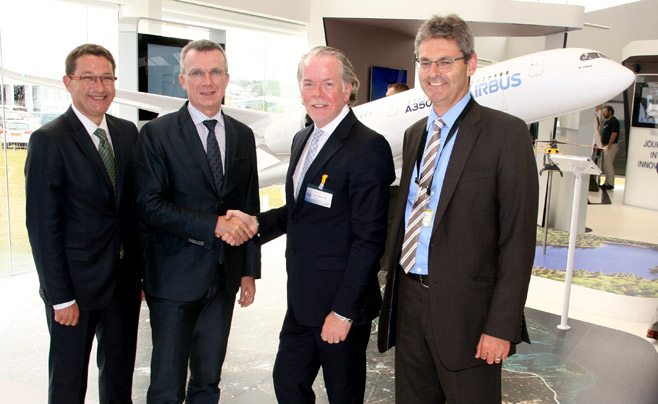Recent news from Stratasys (NASDAQ:SSYS) marks another milestone passed as 3D printing advances, and becomes further integrated with traditional manufacturing processes.
The aerospace industry was an early adopter of 3D printing with the advantages conferred by design freedom and eliminating surplus material making the technology uniquely suited to an industry where parts must be highly reliable but also not excessively heavy: which would lead to higher jet fuel costs.
Within the aerospace industry, French aviation company Airbus (FRA:AIR) have long been at the frontier of bringing additive manufacturing into their business.
From a single titanium cabin bracket in 2014, to over 1000 3D printed parts now in service on the Airbus A350 XWB aircraft today, becoming a standard within aerospace manufacturing was only a matter of time for Stratasys. Airbus have just announced it is standardizing on ULTEM™ 9085 3D printing material for use in the A350 XWB. Of the announcement Andy Middleton, President at Stratasys EMEA said,
“In 2014, Airbus produced a significant amount of parts on its Stratasys FDM-based 3D Printers for use in new A350 XWB aircraft, enabling Airbus to meet delivery commitments on-time. We are pleased to support Airbus as they industrialize the inclusion of Stratasys 3D printed parts in the A350 XWB production supply chain, ensuring that suppliers will be able to support continued scheduled aircraft deliveries.”

ULTEM™ 9085 is a high-performance thermoplastic, offering similar possibilities to PEKK, another high grade material and manufactured by Oxford Performance Materials (OPM). Regarding their ultra-high performance polymer PEKK – branded as OXPEKK® – OPM say it offers, “high chemical and radiation resistance, high tensile and compressive strength, low-to-high temperature tolerance, tailored electrical properties, and high purity with ultra-low outgassing.”
$15 billion contract updated
OPM partners Hexcel Corp (NYSE:HXL) were also included in the Airbus announcement with the news of an update to their $15 billion supply contract. Hexcel make a range of advanced materials including composites for aerospace. Earlier this June Hexcel announced an investment in the privately owned Connecticut company OPM and CEO Scott DeFelice, commented “Hexcel represents the gold standard in carbon fiber and composite material technologies, and our core target markets are extremely complementary.”
ULTEM’s strength in service also has a flipside. The highly durable material isn’t the easiest to work with, but once mastered it offers outstanding strength and resistance, while remaining lightweight. These properties combined are what makes ULTEM ideal for the aerospace industry. With its FST (flame, smoke, and toxicity) rating, ULTEM 9085 is now certified to Airbus material specifications and, as with all approvals of this kind, it offers potential solutions to manufacturing costs and production time.
“We see the demand for our additive manufacturing solutions coming from a variety of time-sensitive industries, including everything from aerospace and automotive to medical and consumer products,” added Middleton. “By adopting Stratasys additive manufacturing strategies in supply chain management, companies can not only protect time-to-market commitments but also increase product innovation while decreasing inventory requirements.”
3D printing to infinity
Stratasys are also developing new 3D printing technology for large format components and demonstrated their Infinite Build machine at Chicago’s IMTS in September. The way Infinite Build works is by flipping traditional 3D printing onto its side – so the build bed is vertical rather than horizontal. The object is fabricated by FDM as extruders print out materials over a conveyor belt. As the layers build-up, the print-bed moves along horizontally meaning that the size of the object being printed can be almost, as the names suggests, infinite. Though no explicit mention has made about Airbus using the Infinite Build for aircraft components, it wouldn’t be too much of a stretch to assume this is one of the methods both companies will using as the continue to explore the future of aircraft construction.
Featured image: An Airbus A350 photo via: REUTERS/Jean-Philippe Arles/File



